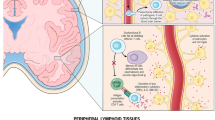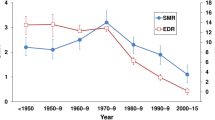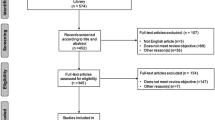Abstract
High-dose cyclophosphamide followed by autologous haematopoietic stem cell transplantation (HDC-AHSCT) is a treatment option for aggressive and refractory multiple sclerosis (MS). Natalizumab is a monoclonal antibody approved for relapsing-remitting (RR) MS unresponsive to immunomodulating drugs. Nothing is known about the use of natalizumab in patients after HDC-AHSCT. We describe five female RR-MS patients with incomplete response to HDC-AHSCT. Natalizumab was then administered with abolition of both MRI and clinical activity. No severe adverse events, in particular opportunistic infections such as Progressive Multifocal Leukoencephalopathy (PML), were observed. Our results suggest that the use of natalizumab in aggressive RR-MS after HDC-AHSCT could be effective and safe. The very long-term risk of adverse events due to sequential aggressive immunosuppression has to be established.

Similar content being viewed by others
References
Daumer M, Griffith LM, Meister W, Nash RA, Wolinsky JS (2006) Survival, and time to an advanced disease state or progression, of untreated patients with moderately severe multiple sclerosis in a multicenter observational database: relevance for design of a clinical trial for high dose immunosuppressive therapy with autologous hematopoietic stem cell transplantation. Mult Scler 12:174–179
Ikehara S, Good RA, Nakamura T, Sekita K, Inoue S, Oo Mm, Muso E, Ogawa K, Hamashima Y (1985) Rationale for bone marrow transplantation in the treatment of autoimmune diseases. Proc Natl Acad Sci USA 82:2483–2487
van Bekkum DW, Bohre EP, Houben PF, Knaan-Shanzer S (1989) Regression of adjuvant-induced arthritis in rats following bone marrow transplantation. Proc Natl Acad Sci USA 86:10090–10094
Uccelli A, Mancardi G (2010) Stem cell transplantation in multiple sclerosis. Curr Opin Neurol 23(3):218–225
Mancardi G, Saccardi R (2008) Autologous haematopoietic stem-cell transplantation in multiple sclerosis. Lancet Neurol 7:626–636
Mancardi GL, Saccardi R, Filippi M, Gualandi F, Murialdo A, Inglese M, Marrosu MG, Meucci G, Massacesi L, Lugaresi A, Pagliai F, Sormani MP, Sardanelli F, Marmont A (2001) Autologous hematopoietic stem cell transplantation suppresses Gd-enhanced MRI activity in MS. Neurology 57:62–68
Saccardi R, Mancardi GL, Solari A, Bosi A, Bruzzi P, Di Bartolomeo P, Donelli A, Filippi M, Guerrasio A, Gualandi F, La Nasa G, Murialdo A, Pagliai F, Papineschi F, Scappini B, Marmont AM (2005) Autologous HSCT for severe progressive multiple sclerosis in a multicenter trial: impact on disease activity and quality of life. Blood 105:2601–2607
Seshadri T, Pintilie M, Kuruvilla J, Keating A, Tsang R, Zadeh S, Crump M (2009) Incidence and risk factors for second cancers after autologous hematopoietic cell transplantation for aggressive non-Hodgkin lymphoma. Leuk Lymphoma 50(3):380–386
Mancardi GL (2008) Light trial. EUDRA CT number n2006-002562-19. http://eudract.emea.europa.eu. Accessed 29 May 2008
Havrdova E, Galetta S, Hutchinson M, Stefoski D, Bates D, Polman CH, O’Connor PW, Giovannoni G, Phillips JT, Lublin FD, Pace A, Kim R, Hyde R (2009) Effect of natalizumab on clinical and radiological disease activity in multiple sclerosis: a retrospective analysis of the natalizumab safety and efficacy in relapsing-remitting multiple sclerosis (AFFIRM) study. Lancet Neurol 8:254–260
Mouzaki A, Koutsokera M, Dervilli Z, Rodi M, Kalavrizioti D, Dimisianos N, Matsoukas I, Papathanasopoulos P (2010) Remitting-relapsing multiple sclwerosis patient refractory to conventional treatments and bone marrow transplantation who responded to natalizumab. Int J Gen Med 3:313–320
Gold R, Jawad A, Miller DH, Henderson DC, Fassas A, Fierz V, Hartung HP (2007) Expert opinion: guidelines for the use of natalizumab in multiple sclerosis patients previously treated with immunomodulating therapies. J Neuroimmunol 187(1–2):156–158
Ledda A, Caocci G, Spinicci G, Cocco E, Mamusa E, La Nasa G (2006) Two new cases of acute promyelocytic leukemia following mitoxantrone treatment in patients with multiple sclerosis. Leukemia 20(12):2217–2218
Burt RK, Loh Y, Cohen B, Stefoski D, Balabanov R, Katsamakis G, Oyama Y, Russell EJ, Stern J, Muraro P, Rose J, Testori A, Bucha J, Jovanovic B, Milanetti F, Storek J, Voltarelli JC, Burns WH (2009) Autologous non-myeloablative haemopoietic stem cell transplantation in relapsing-remitting multiple sclerosis: a phase I/II study. Lancet Neurol 8:244–253
Centonze D, Furlan R, Gasperini C, Salvetti M, Battistini L (2008) Early relapses after the first dose of natalizumab in active multiple sclerosis patients. Multiple Sclerosis 14:1137–1138
Muraro PA, Douek DC (2006) Renewing the T cell repertoire to arrest autoimmune aggression. Trends Immunol 27:61–67
Krumbholz M, Meinl I, Kumpfle T, Hohlfeld R, Meinl E (2008) Natalizumab disproportionately increases circulating pre-B and B cells in multiple sclerosis. Neurology 71:1350–1354
Conflict of interest
This study was not sponsored. M. Capobianco received grants from Biogen-Idec, Biogen-Dompè, Sanofi-Aventis, Schering-Bayer, Merck-Serono and Teva. A. Bertolotto has served as a consultant and received research grants from Biogen-Idec, Biogen-Dompè, Sanofi-Aventis, Schering-Bayer, Merck-Serono and Teva. M. G. Marrosu has served as a consultant and received research grants from Biogen-Idec, Biogen-Dompè, Sanofi-Aventis, Schering-Bayer, Merck-Serono and Teva. J. Frau received grants from Biogen-Idec, Biogen-Dompè, Sanofi-Aventis, Schering-Bayer, Merck-Serono and Teva. E. Cocco received grants from Biogen-Idec, Biogen-Dompè, Sanofi-Aventis, Schering-Bayer, Merck-Serono and Teva. E. Mamusa received grants from Biogen-Idec, Biogen-Dompè, Sanofi-Aventis, Schering-Bayer, Merck-Serono and Teva.
Author information
Authors and Affiliations
Corresponding author
Additional information
M. Capobianco and Y. Motuzova contributed equally to this work.
Rights and permissions
About this article
Cite this article
Capobianco, M., Motuzova, Y., Frau, J. et al. Natalizumab in aggressive multiple sclerosis after haematopoietic stem cell transplantation. Neurol Sci 33, 863–867 (2012). https://doi.org/10.1007/s10072-011-0848-1
Received:
Accepted:
Published:
Issue Date:
DOI: https://doi.org/10.1007/s10072-011-0848-1




